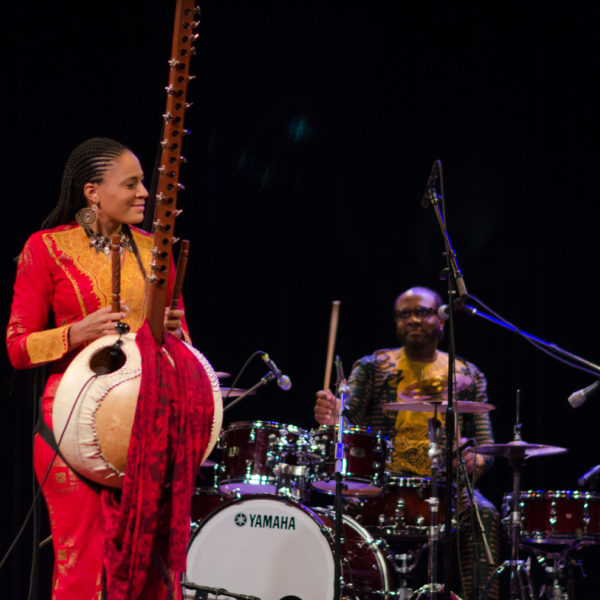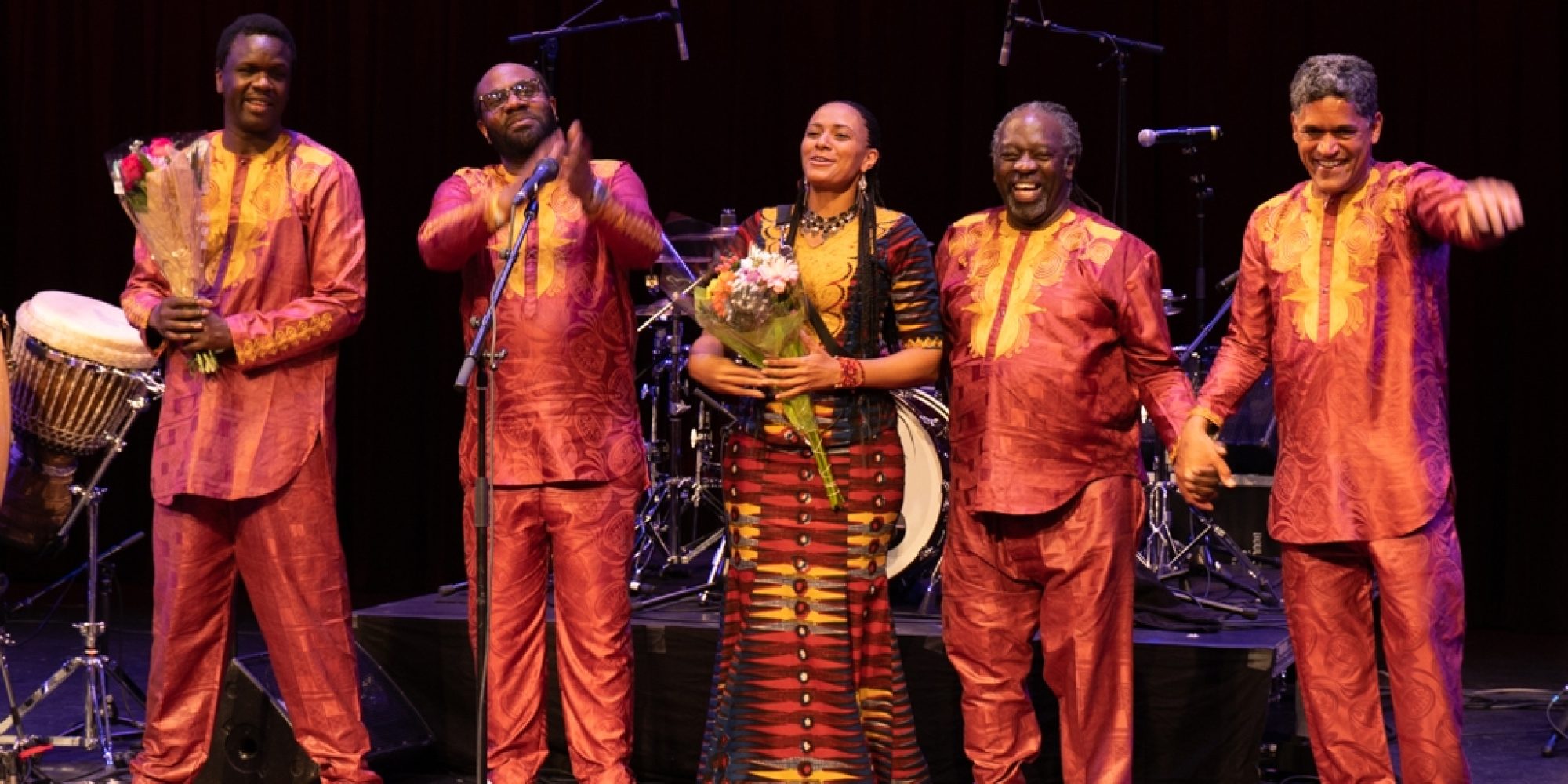Sona Jobarteh stands alone among contemporary kora players. The daughter of a Gambian griot father and an English visual artist mother, she grew up with feet in two worlds. Classically trained, as she told us in an earlier interview, she ultimately turned to the kora and Manding tradition. As she explained in her recent "60 Minutes" feature, Jobarteh is also deeply involved in reimagination education in Africa. She started a school in Gambia, and speaks often on education issues. A maverick activist, instrumentalist and composer, she has a new album coming out in late January 2023. It’s called Badinyaa Kumoo. Banning Eyre spoke with Jobarteh over Zoom from her home in London. Here’s their conversation, with some editing for clarity.
Banning Eyre: Sona, nice to speak with you again. Where am I reaching you?
Sona Jobarteh: I'm in London today and then I travel tomorrow again.
You’re on the move. I know you were just in Gambia recently.
Yeah, yeah. I'm going back. I'm putting a pause on touring so intensively towards the end of this year so I can just go back and focus on everything that I’ve sort of abandoned recently. Well, not abandoned, but not been able to do properly.
With the school?
Yeah, yeah. Since the calendar has been so busy lately, it's been really hard to to fulfill both, so yes, I'm looking forward to that. I just need to be there and make sure things will tide over until I’m back again.
Let me start with the last time I saw you, which was around the 60 Minutes interview. How did that broadcast affect your life and career? I imagine you got a lot of feedback from that.
Sure. It’s been great, obviously. Sales have gone up a lot. And the hype. Luckily, I’m at the stage where I’m not dealing with the admin anymore. So they’re all happy now. Thankfully, it’s not been too stressful for me, but it's very positive.
It is gratifying for a U.S. show at that level to pay attention to African music. I was pleased that that happened, and to play a small role in it.

Let’s talk about this album, Badenyaa Kumoo, which I’ve been enjoying. It’s a nice movement forward from from the last one. Tell me about the overall concept, what you were trying to do with the album.
The concept is very much rooted in closing the gap a little bit between my musical profile, what I do as an artist and performer, with the other work that I do with education, which is in many ways the unseen side, but which is actually the most important part to me. So I wanted to make sure that I could kind of reduce the load in terms of being schizophrenic in a way, being this artist/performer that people obviously appreciate from that angle, but also that other angle being quite separate as well. Because in the realm of education and all that other work, it doesn't have much to do with music. This was kind of my main goal, to just be a little more honest about who I am and to fuse those spaces into one space. That was probably the big overarching aim of this album.
Then from there, I was dealing with each track and what it represents, what I'm speaking about, and the artists I chose to work with in specific areas. That’s really how this journey was informed.
When you say your other work doesn't have much to do with music, tell me more. I know that part of your educational work has to do with history, but in the world of griots, history and music are aligned, right? So what is the part that is beyond music?
Of course my very active role has been within the area of developing an academic curriculum, a new curriculum. I’ve had the opportunity of being a speaker, so people who know me as a speaker don’t know me as an artist, and vice versa. Being at U.N. summits or the World Trade Organization has got nothing to do with music at all. There I’m talking about development, talking about education, talking to heads of state. Dealing with that side is like being totally another person to the person that goes up on stage with a kora and sings to people.
Likewise, those people are often very surprised to know, “Oh, she’s also a singer.” I’ve found it difficult embodying these two very different worlds, and like I said, the people who follow me on one are not aware of the other. That's been a challenge, and this album has been a way of starting to bring those two together, to talk about it more, as I’m doing now, and to try and marry those two together. The education work that I'm doing in creating this curriculum is very much an academic enterprise, not much connected with music. Music is an aspect of curriculum, but it’s not the overarching one.
When you talk to heads of states and people like that, what is the core of your message to them? What are you trying to get them to think about that maybe they're not thinking about now?
Well, that totally depends, because some of the panels that I'm on and some of the forums I'm talking at are very specific. Some are dealing with gender. For example, one of them at the W.T.O. was about how to get women into entrepreneurship more, and obviously the heart of that was education. When I did the work with the U.N. summit, that was very much to do with urban development and how we can approach it being sensitive to cultural requirements. This is why I was brought on, to talk about how to express culture through urban development. I was really calling on heads of state and to take culture more seriously in their urban planning. I would say that's probably the common denominator in pretty much everything I do. I don't like using the word because sometimes it can be regarded as this kind of fuzzy, artistic thing. I mean it in a very pointed way, meaning this is actually the foundation building block that we would use for development in many different ways, whether it’s to do with infrastructure or with education, even health care, because that also has to take consideration of the culture.
When we’re talking about urban spaces, or even the rural planning departments, they kind of have these great ideas of how to structure spaces within the rural environment, but disregarding the fact that men behave like this in public spaces, and women behave like that in public spaces, music is done like this... without taking into consideration that there are many great projects with very low outcomes at end of the day.
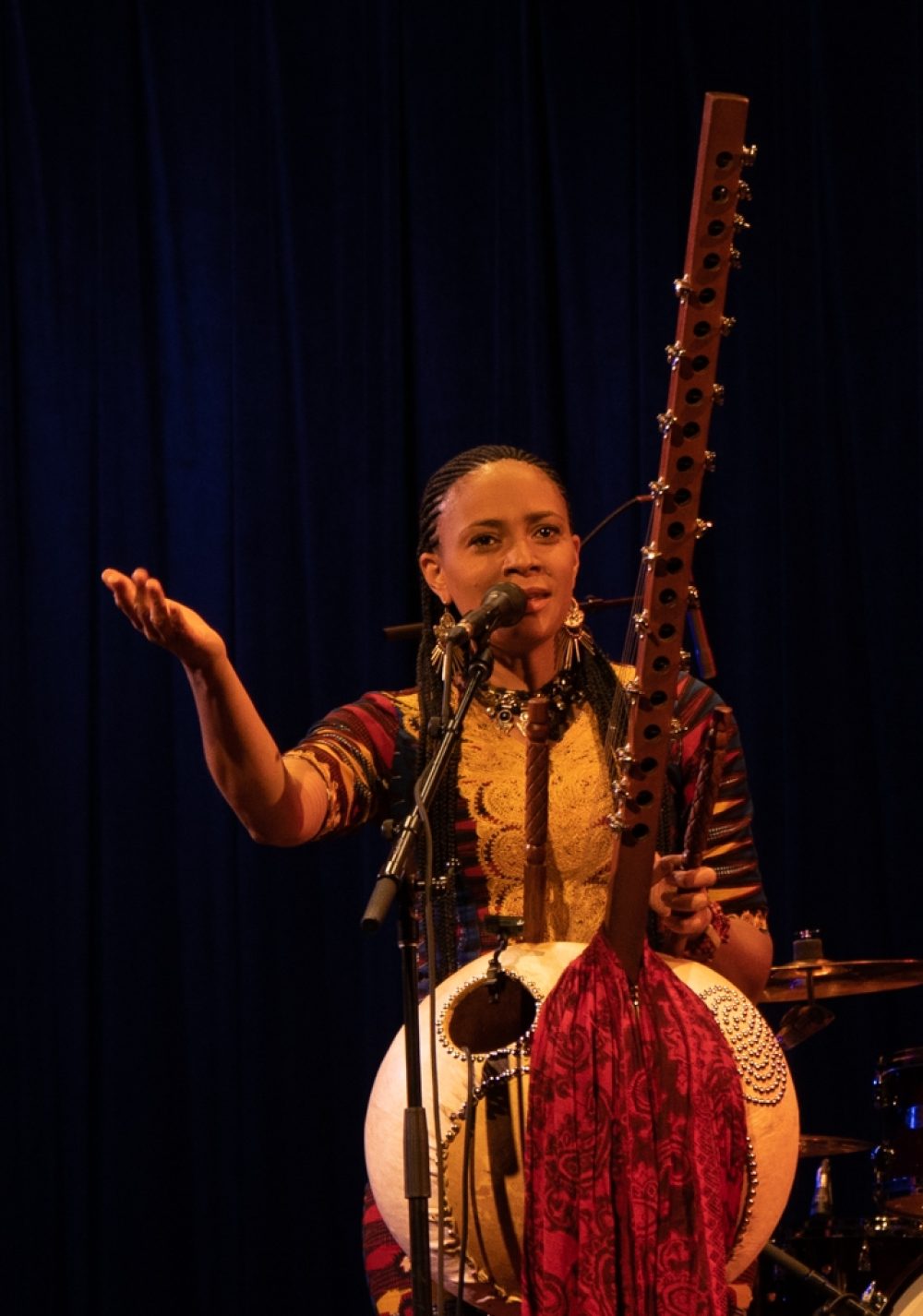
Let’s switch to the music side and dig into the album. We start right off with “Musolou,” which means “women.” It’s a beautiful song. By the way, there’s a great balafon solo in there. Who is that?
That is Lansana Kouyate.
Talk about the song. What does it say?
This song is in two parts, actually. I had a lot to say, which is really challenging. That’s probably the most challenging thing. That’s why I often say that I'm a I'm a musician-instrumentalist more than a vocalist. I always get to this point when I write where I know everything that I want to say, and then I realize I've got one verse here, and each line is just 10 beats. Oh god, how can I say all of this? The song is going to be 20 minutes long, right? That's always a big sacrifice for me. That’s why in the album notes I don't just put the translation. I explain the meaning because I feel I had to leave so much behind. I literally wrote pages. “Musolou” was pages long. That’s how I do the process. I just write my thoughts, my feelings, and then I start boiling it down to two pages, then one page and then you’ve got to figure out how to get it down to three lines, and then lines that actually fit the rhythm, because I don’t write the melody off the words. I write the vocal melody first and then I’ve got to fit the words in.
Ah ha. So you start with the melody before the words.
Yes. Always. Because I'm always thinking of the melody and rhythm first. The words are always the last thing that I do. I prefer to compromise and sacrifice more on the words than I will on the rhythm or the melody. So that always is a massive challenge and I always feel that there's that loss that I had to go through in terms of not actually being able to say everything. But what I decided to do with this song is to sort of split it into two halves, so I have the first half really talking about the celebration of women: how much we value women celebrate what women contribute to society. And then the second half is looking at the ways in which women are not appreciated in society in general. It’s specifically talking to men and calling on them to actually educate the next generation to educate their sons be an active part of that change.
That’s what we do at the Academy. I have a lot of very potent sessions with the boys, which I always find even more exciting than the girls, because we know the struggles women and girls go through. What’s very interesting and so empowering is to hear the boys talking about it and then getting the boys to think about it and talk critically about what they agree with, what they disagree with, and why. It is so exciting. So, for me, it’s talking from that experience that I have as well, working with boys in the community.
That’s interesting. I guess that's where the change really has to happen.
It is. Because we have a society, and we can’t take men out of the equation.
No, indeed not. That’s where a lot of the problems lie, isn’t it?
Let’s talk about the song you did with Youssou N’Dour, “Kambengwo.”
Kambelengwo means “unity.” I have to say it's the hardest song I've ever done in my life. It’s one that took so much out of me on every single level. You’ll hear that there are two sections to it. That’s because I wrote two different songs, and actually it was the drummer in my band who told me, “Just make it one song. Put the two together.” And I was, “No way. That’s going to sound really weird.” So at that point, I was deciding which one do I go for? But he kind of put this seed in my head to do both, so I did. That’s why you hear there’s sort of a pickup halfway through.
Right. There’s a bit of mbalax in it.
Right. So it was definitely an ambition to be able to bring in mbalax into the music. That’s something I grew up hearing, something that is a huge deal in the culture of Gambia, especially as we’re part of Senegal as well in terms of culture.
Yes. It’s only separate because of history.
Correct. It’s only separate because of the colonial division. It is the same people, the same culture. So I just wanted to make sure I paid some regard to that and brought that in to the music in some way. That was one element, but then the other was that I always knew from the very beginning of even starting to write, that my ambition was to write a song for Youssou, not just because of who he is and his stature within that particular region of Africa, but also because he represents what I was actually talking about in the song, which was really its focus on the concept of pan-Africanism, the idea of African unity, but also being able to have African role models. That's the power in that, not just in music and the arts, but also in the in economic development, again talking from the kind of environment that I am in when I'm a speaker. We're talking about economic development and infrastructure development, and having role models in those areas is important. Youssou is a huge, iconic cultural icon in music, but we also need to acknowledge that he's a hugely successful business person, an entrepreneur. Right?
Absolutely. He’s a rare example of combining those two skills at such a high level.
That for me is truly inspiring for people from all over the continent. His music is always kind of pulled out, but it’s just as important to celebrate that other side of him too. So that was another reason why I really wanted to bring him on board with that song and have him featured. It was also the first time for a Gambian artist to collaborate with Youssou. That was a big deal to me as well. So many reasons. But it was hugely challenging as well. This song took so long to put together because I had to record different elements in different countries, and the system of recording in Senegal was very different as well.
That was the only song where I allowed another engineer to record some parts of it, but I had issues with that because there were problems that I was trying to sort of rectify, but again this is where gender plays a role. It was difficult to jump on the engine and say, “You're not doing it right,” because I'm a woman. There were all these kind of dynamics that I had to deal with, and I've got to fix the problems when I get out of there, and make everything work and seem like it was all done at the same time, as if everyone just got in the room and started playing together, when it totally wasn’t that. It was going back and forth and back and forth to Senegal when they didn't do it right, rushing and there’s squeaking in the background… And then when I got back there were weeks of editing. I mean I've never edited like that before. I mean there's parts on there that I could say I literally created through editing. It was crazy and I don't ever want to have to do that again.
But I was determined. It's got to be right, especially if I'm getting someone like Youssou to sing on it. At the end, when it's all done I want that voice to come on top and so it had to be right and I had to just keep going until it was good enough for me to finally get Youssou on board.
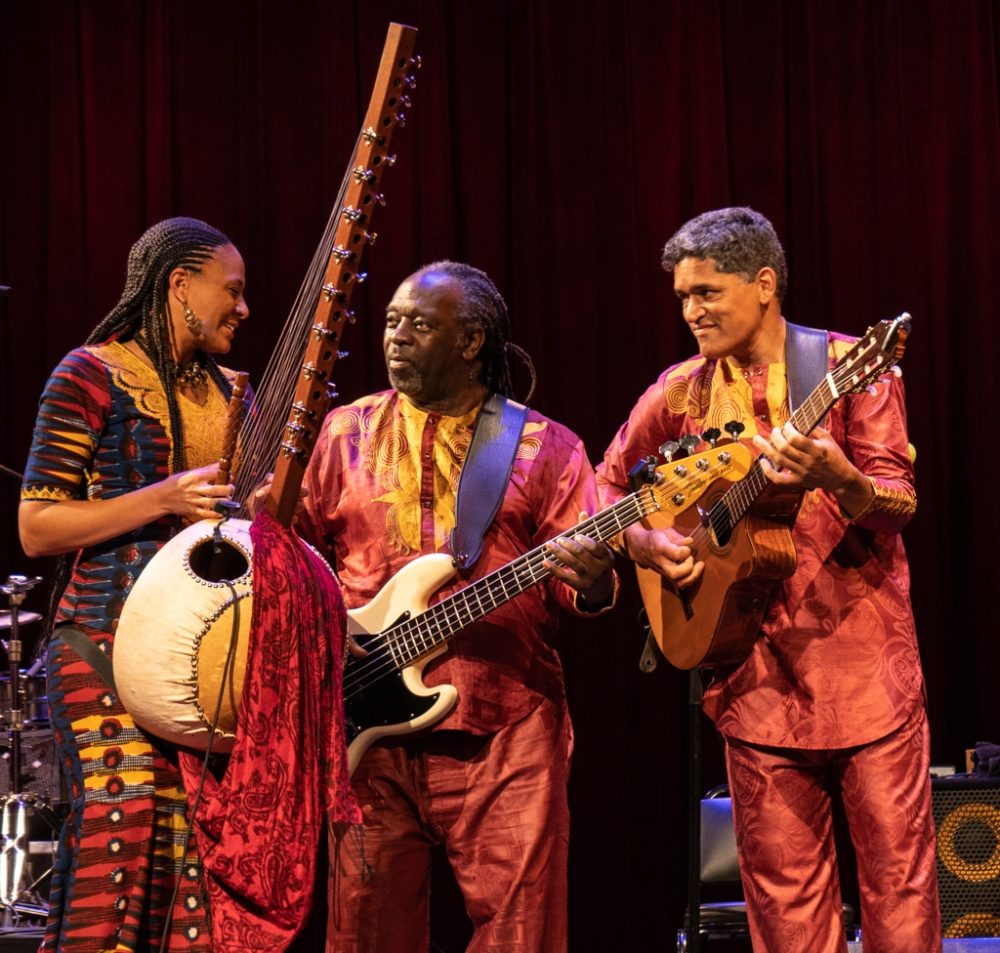
Well, the result is wonderful. I would never have imagined there was all that behind it. It’s interesting what you're saying about Youssou himself. We've often noted that he is a better ambassador for Africa than any politician outside of maybe Nelson Mandela. We have often been in the position of talking to people in official positions who we feel are devaluing culture and art and music, not seeing how powerful it can be as an opening to the world.
Exactly.
I love the the piece you did with Ballaké Sissoko, who's an old friend and such a beautiful kora player. I wrote in my notes that this song “Ballaké” sounds like two koras making love.
[Laughs] Of course, that has to be one of the highlights of my career. Honestly, it has to be because he's been a role model for me and so many of my generation. I don't even remember when I first started listening to Ballaké as a child. He is someone that just touches me deeply as a player. I'd say, other than my father, those are really the two that have inspired me the most. What’s interesting about this collaboration is that it wasn’t actually me who initiated it. He had approached my team to do the collaboration on his album, Djourou. I just thought, “You know what? There's no way I want this to be a session where I go there and he pays me. No. This is something deeper. He's given me so much as a musician over the years. This needs to be something that has some meaning.”
Especially in this culture. In many ways, musically, he’s a father figure in terms of the next generation. So what more beautiful way than to have it as an exchange where I play a song for him and he plays a song for me, and that was what we did. Just after we had finished recording his song, I played him the rhythm to this song and he was like, “O.K. Let’s go.” We did three takes and that was it. It was it the easiest song I did on the entire album. Everything else was not that easy. Well, I say easy, but I was playing with my heart in my mouth, literally. But at the same time it was perfect.
So nice. And aside from Ballaké’s musicality and excellence as a kora player, I love the way he's so collaborative and experimental. He’s done so many different things. I particularly love his song with Salif Keita, “Guelen.” It’s one of my favorite Salif recordings, showing such a different side of his voice.
Yes.
While we’re on kora, I don’t know whether you heard our program Journeys With the Kora. You’re in it, and it was one of our best received shows last year.
O.K., let’s go to “Fondinkeeya,” a really funky one with great percussion in the mix.
At the beginning I kind of just wanted to… I just kept thinking, “O.K., how do I push the boundaries? Fasiya[her prior album] is there. It's got to be something different.” So I just thought, “You know what? In my genre I have never heard a song in seven or in five or 13. You know what I mean? That's always associated with jazz and art music and whatnot. But who’s to say it's not possible? Oh, you’re kidding yourself. People hear this in Gambia and they’ll say, “What? Are you crazy?” But I had this idea in my head. “No. I'm going to try and see if it's possible.” My aim was to do it, but I wanted it to be done in a way that when people heard it they wouldn’t know necessarily it’s in seven.
Like Pink Floyd’s “Money” a great example of that in the world of rock.
Right. I wanted it to have enough rhythm and pull for them to get fooled into just thinking it’s a normal time signature. You know, I've been exposed to jazz and so on, and I'm always very conscious when they go into a section of music and everyone is, “Oh, this is a different time signature. This is complicated, right?” And it’s always this thing of wanting to come across as, “This is complicated. You won't understand it.”
Sure. But it’s much cooler to do it so people don’t notice.
Yes. Why exclude people with complexity? Why not include them into that complexity? So I just wanted to see if I could do it. I wasn't sure, honestly, I when I started out, but I just wanted to try it myself, and if I fail, I fail. If it works, let’s just take it and see how far it goes. So it was really an experiment. This song is an experiment. What was crucial to me was just getting a hook line that had a swing, that had a groove, and that’s the first thing you hear on the song, the guitar line. That was the hook that I found. Then I thought I could hang the rest of this song on this, because I feel like this guitar line has enough rhythm that I can disguise the seven in it.
Then the meaning of the song came after having written it. That was really just about innovation, about preservation through innovation, which I often talk about. We must preserve our sound and our culture, but we must also innovate. Otherwise it just becomes boring and old. So “Fondinkeeya” refers to youth and education. This is really the song dedicated to the Academy in the idea and the concept of having to innovate to keep renewing our traditions and the concept and the approach, in order to keep it going, to preserve it. So it was within that framework of creating a song that was not something that would normally be done in this in this particular genre.
That works on both levels. Then you have to have the song “Gambia,” which pre-existed, right? It’s kind of a love song to the country. There’s a nice video of that one, and I think we spoke about it last time.
Yes.
Let's talk about “Nina Mooya,” featuring Kirk Whalum on saxophone. I think you were recording him the first time I met you in New Haven. You mentioned that you were recording with a saxophonist.
Yes! Right! Exactly. That was you. That's so funny. Wow, look at that. Full circle. “Nina Mooya” refers to our humanity. Yes. It's our humanity. What was interesting about that was that I had written the song and at the beginning I had not really thought about sax. But it became stronger and stronger as I continued writing, that I was hearing saxophone. I already had the story in my mind that I was talking the transatlantic slave trade and the legacy of that both on the continent and in the diaspora, so I wanted to have a voice from that tradition, right? From that story on the other side. I knew it was going to be an instrument like the saxophone. I was not very sure but it kind of came up stronger and stronger until, “Yes. It’s definitely sax.”
Kirk was someone I met at the Majorca Jazz Festival where I just heard him playing. It was so interesting because he was up on stage with like five other saxophone players who were just as crazy technical as him, literally doing gymnastics on these instruments. It was ridiculous. Most of the time, my jaw was on the floor, but what touched me was the fact that… And I didn't know Kirk at the time. He was just another amazing American saxophone player. But as soon as he played just the first note, ooooh I felt it. There was his phrasing and sort of an energy in his playing that even with the crazy hundred-notes-a-second, if he hadn't done any of that I would've been just as moved. Playing at 100 miles an hour didn't move me with the others, but he moved me and he touched me on a musical level.
For me, that’s what music is about. It’s communication. It’s touching people. So that’s when I was like, “Wow, I want to work with him.” And amazingly, it worked, and you complete the story. Sometimes things just seem too coincidental to be true. But then I happened to be in Washington and he was there. “Can we do it in the hotel?” “No, we can’t do saxophone in a hotel. The manager will come.” “Yeah, that’s true, but where do we go?” I didn't actually know where we would go. It was just madness. I knew someone in Senegal and called him, and he said, “Yeah I have a friend like just down the road from where you’ll be [in New Haven].” So he called this guy and this guy said, “Come over,” so I just said to Kirk, “Right. We're going to this address. I don't know who it is or where it is.” We show up there in this living room and we put up a mattress in the corner of the room—not a way to treat a world class saxophone player, but it was what we had to do. It was what we came up with. No complaints.
Well, it’s a beautiful song. I hear in it a sort of dark echo of the song “Jarabi,” which I think is kind of a signature song for you. I think of “Jarabi” as not exactly one song, but a family of related songs with different variants and cousins. Do you know what I mean?
That’s never consciously cross my mind. This one is in a different scale altogether.
Yes, that’s where the darkness comes in.
Maybe the two chords going back in forth. Yeah, perhaps. But it was not conscious.
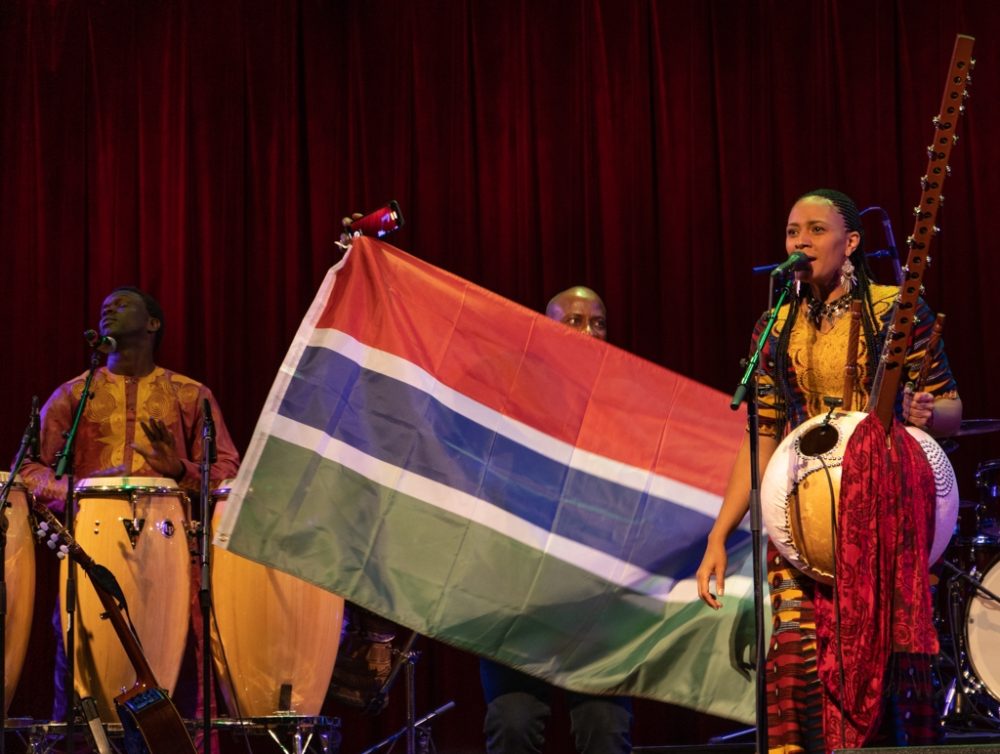
Let’s talk about on the last song on the album, “Taariko,” which has the feel of the northern desert to me. With the violin, it has that northern feeling going up towards the Sahara.
That one was influenced mainly by the takamba, actually. [Takamba is a rhythm and dance shared by the Songhai and Tuareg peoples.]
Well, there you go.
I don't know why, I just relate so much to the takamba, but obviously this song takes in so much more than just the takamba musically, but in terms of my access point in writing and where I started from it was definitely that. But again, I kind of took the takamba rhythm and kind of morphed it. I didn’t want to do a straight takamba; I wanted to kind of bend it a bit, change it a bit, flip it on his head and see how that opened up a new way of expressing this music. For that song I started, unusually, with the rhythm first and then branched out from there.
It's talking about the importance of history and I think the sadness that I feel with the neglect of African history and how there are absolutely amazing sites across the continent that are just not known about by Africans or Europeans. You know, people can go to Europe and be the first in line to visit the Colosseum or the Eiffel Tower, and yet they never even know about the existence of these types of monuments and sites we have in Africa that predate those by thousands of years. So that’s the story I was telling, how that disconnection has an impact on the cultural identity of a people, when they are not connected to their history. This was that story and that’s why it was very meaningful to use takamba and to have that connectedness to history, and also then bringing on the two guests on that song, one who plays the xalam lute, and then the singer.
That’s Zihirina Maiga. He’s the male voice, a beautiful, old craggy voice.
Yes. He’s literally one of the last, the last of his generation, who sang in that style and he spent awhile talking about the fact that no one is coming to him to learn. He said, “When I'm gone I'm taking it with me, because nobody is coming to me to learn.”
Is he from Mali?
Yes. From Gao. So that was again a challenge. “How am I going to get to Gao?” I was wondering how am I gonna get my equipment out there to record. And again, certain things just happened. I knew someone in Ghana who was from Niger and speaks the same Songhai. I didn’t speak the language, and they didn’t speak French either so there was no way to communicate at all. So I called my friend just because he speaks Songhai, but he told me that the Songhai that they speak there is like from the museum. Even he said that. Songhai is his first language but hearing Zihrina speak is like hearing a museum talk. “We don’t hear this type of Songhai.” So that was amazing, but he facilitated them to actually get a U.N. plane from Gao to Bamako, and then from Bamako to my house in the Gambia. I couldn’t believe it. It was almost impossible. We had to get passports for them. They didn’t have passports. They came for two days just to do that one song, to record it.
And what you referred to as a violin on there; that’s actually cello, which I'm playing because I wanted to play cello.
Right. That was your instrument when you played classical music. I remember that.
Yes. I used to play cello another lifetime ago, and I thought, “Why not?” So for one song on the album, I get to bring out the cello again, even though it’s not recognizably cello sounding. Yes, again, twist it on his head.
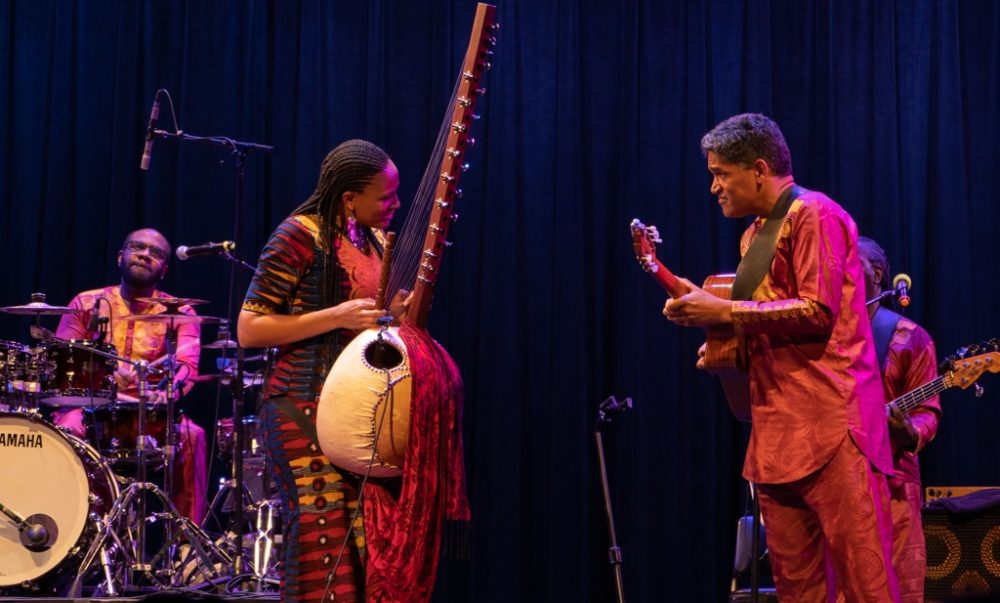
It’s appropriate to end with history, given your goal with this album. I haven't actually seen the liner notes yet, but I imagine I'll learn more when I do. Tell me the meaning of the album title, Badinyaa Kumoo.
I actually got this title from the same person who gave me the title of my last album, Fassiya. That was important to me. Within this culture, I feel it’s very meaningful to have the name given. It's a bit like your child, you know, to be given the name by the family. So for me, that was a gesture. You must know professor Cherif Keita.
Yes, the scholar at Carleton College in Minnesota. A great man and a good friend of our program.
I've been to him both times because I feel that that combines everything for me. It's coming from the voice of somebody who is deeply rooted within from a historical point of view. He gave me the name Fassiya for my previous album. So I went back to him. I said, “Here's the album. Listen to all the songs. You will know what I'm talking about and find the most culturally relevant, deep rooted title that you can figure out, and it will be a blessing to me.” And he came up with Badinyaa Kumoo.
What does it mean?
So badinyaa is connected with fassiya. Fassiya is the paternal father’s line, and badinyaa refers to the mother figure. It’s a cultural concept; it's not just the mother who has kids, raises them and looks after them. Yes, of course, that’s an element, but we are actually talking about another level of humanity, the fact of the role of the mother figure within the family unit. In Manding culture, that represents the unity that you have between the children of that one mother. You know, you have different mother figures within the same family. But the unity between the brothers and sisters, even though they’re in the same family, there's a different brother and sister relationship when they’re from one mother.
This is a deep rooted cultural thing that everybody knows. That’s why when you say you’re “my brother” you have to follow it up by saying “same mother.” So as I was talking a lot, Professor Keita said, “You're talking about that unity.” And kukmoo is just “words.” But again there’s a cultural meaning. There’s a thing in the culture that says animals have tails, and because they have tails, you can catch them. But a human being is one that doesn’t have any tail, so the only way you can catch a human is by their words. So when you speak it becomes like a promise or a commitment, and again, professor Keita said this is referring to me and what I do. It's not just what I'm singing about; it’s what I do. So if we combine those two things, it’s words of unity, but with all those different other elements behind it.
The idea of motherhood brings me to the last thing I wanted to ask you about. You spoke a lot about your father, Sanjally Jobarteh, when we first talked, and also on 60 Minutes. I wanted to ask about your mother, Galina Chester. I don't know much about her.
She was a visual artist. So I had artists on both sides of the family. She was not musical at all, though she had a love of music in any shape or form. Obviously the kora was something she loved, but also classical music. That was her upbringing. So I had definitely that kind of artistic influence from both sides. It was more from my family and the Gambia in general that the musicology came to me in that way, but from my mother I learned a lot about the arts.
Actually, this album also bridged that gap, because for the first time I got back in touch with my artistic side in the visual arts. I worked with a young artist in the Gambia on a visual representation of every single song, which took us months to develop the concepts and ideas and designs, and how they represented what I'm talking about. So that was amazing to be able to get back in touch with that and also to take part in that myself.
Your mother is English.
Yes, yes.
And she is she still around?
She’s still here, very elderly now.
Well, I imagine she's proud of what you've done. It’s lovely to talk with you again, I'm so glad we connected. I imagine I'll be seeing you when you come around on tour again, later this year?
I think it’s between March and June.
Well, good luck with everything.
Thanks so much.

Related Audio Programs
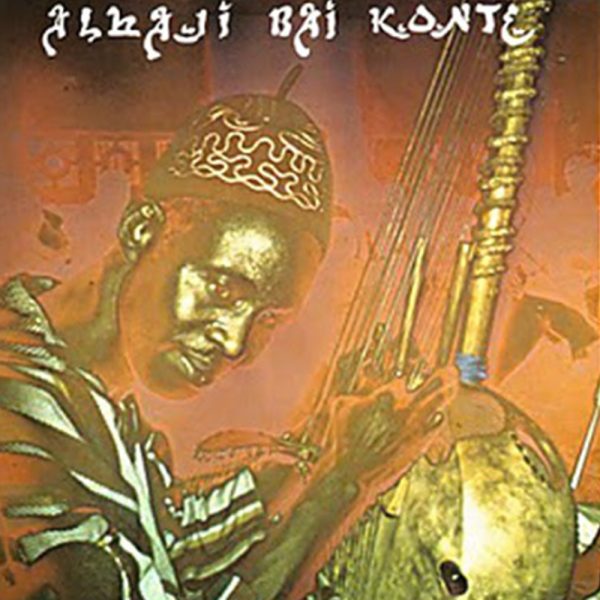
Related Articles
